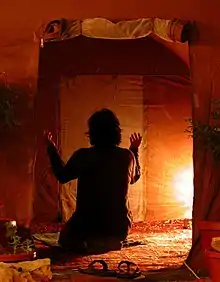Qunut
"Qunut" is a supplication type of prayer made while standing in Islam. For example, it is sunnah (recommended) to supplicate with qunut in the witr prayer during the entire year.
| Part of a series on |
| Islam |
|---|
 |
|
Name
"Qunūt" (Arabic: القنوت) literally means "being obedient" or "the act of standing" in Classical Arabic. The word duʿā' (Arabic: دعاء) is Arabic for supplication, so the longer phrase duʿā' qunūt is sometimes used.
Qunut has many linguistic meanings, such as humility, obedience and devotion. However, it is more understood to be a special du'a which is recited during the prayer.
History
Ahmad, Muhammad ibn `Isa at-Tirmidhi, and Abu Dawood record that Hasan ibn Ali learned the prayer from Muhammad . Dawood further added that Muhammad used to recite al-Qunut whenever a major difficulty or disaster befell the Muslims. Ibn Ali said: "The Messenger of Allah taught me the [following] words to say during the witr prayer:
"O Allah! Guide me with those whom You have Guided, and strengthen me with those whom You have given strength, take me to Your care with those whom You have taken to Your care, Bless me in what You have given me, Protect me from the evil You have Ordained. Surely You Command and are not commanded, and none whom You have committed to Your care shall be humiliated [and none whom You have Taken as an enemy shall taste glory]. You are Blessed, our Lord, and Exalted."
Muhammad used to recite Du'a al-Qunut during Salat al-Fajr, Witr and sometimes during other prayers throughout the year. It is one of those Sunnahs (Prophetic traditions) which many Muslims do not practice today. He would perform the Qunut in the last Rak'ah of the Salah after performing Ruku and saying "Sami'Allahu liman hamidah" (Allah listens to those who praise him); then put hands across navel/chest or raise hands (whilst still focusing on the place of Sujud) and supplicate the Qunut, after which He would make Sujud and conclude the prayer.
Customs
It is permissible to make the qunut before going into ruku (bowing), or it may be recited when one stands up straight after the ruku. Humaid says: "I asked Anas: 'Is the qunut before or after the ruku?' he said: 'We would do it before or after." This hadith was related by Ibn Majah and Muhammad ibn Nasr. In Fath al-Bari, Ibn Hajar al-Asqalani comments that its chain is faultless.
But widely, the scholars of Islam and the regular practice at Masjid al-Haram, Mecca, is to recite the Qunut Prayer after getting up from Ruku, in the last Rakah of Witr i.e., the 3rd Rakah of Witr at Isha (The late night prayer)
According to the Hanafi opinion, one is supposed to give Takbir (Say Allahu Akbar and raise his palms till ear lobes and hold them back below or above navel with right hand over left) before going into Ruku in 3rd Rakah and recite the Following Qunut Prayer also called as Dua Qunut (Prayer of Qunut). After reciting the Dua, Muslims then bend in ruku and perform the rest of the Salath.
Du'a qunut is recommended to be recited in the Witr prayer. The Witr prayer, according to Imam Abu Hanifah is wajib (obligation). The other Imams consider the Witr prayer as Sunnah Mu'akkadah (a recommendation). It can be offered after the Isha prayer right up to the break of dawn.
The minority Ibadi school of Islam rejects the practice of qunūt altogether.[1] However, it is normative in all daily prayers among the Twelver Shia.
References
- Lecture on Ibadi Islam by Valerie J. Hoffman
.jpg.webp)


